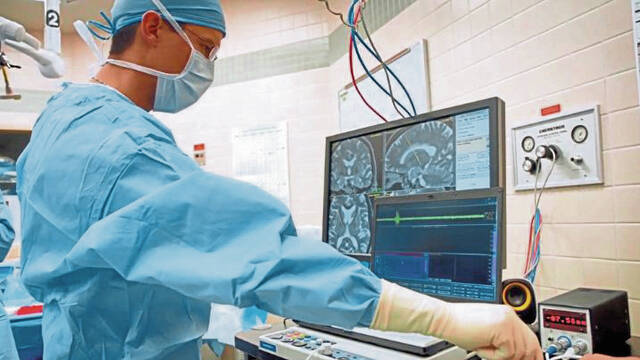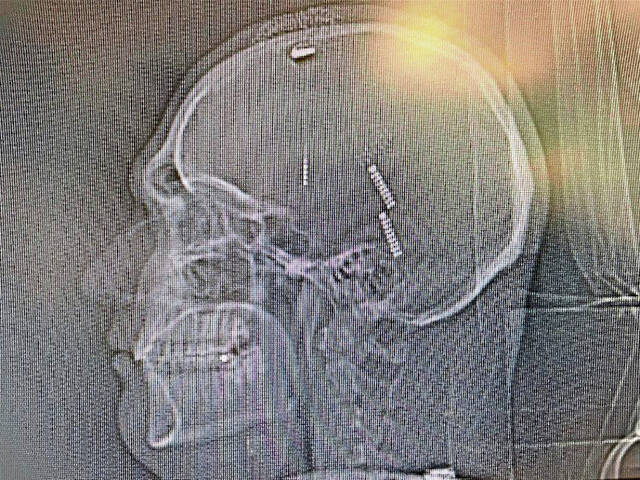AHN study explores treating opioid addiction with electrode implants in brain
An Allegheny Health Network research team is among the first to pioneer a treatment for opioid addiction that targets how addiction affects the brain.
By using a technique called deep brain stimulation, or DBS, the team hopes to reduce the severe cravings that lead opioid addiction patients to relapse and overdose.
“As a neurosurgeon, I’m very excited about being part of the treatment for addiction,” said AHN’s Dr. Nestor Tomycz, who is the study’s principal investigator. “I think it does help reduce the stigma of addiction as being merely poor self-control or a bad habit.”
DBS involves stimulating a specific brain region with electrical pulses. Electrodes implanted in the brain are powered by a pacemaker-like device implanted near the patient’s collarbone. In the study’s specific DBS treatment, electrodes are placed in a region called the nucleus accumbens, which is the brain’s addiction and reward center.
In December, the team implanted DBS electrodes in the brain of a 28-year-old man from New York with treatment-resistant opioid addiction. Team members will follow his progress over the course of the next two years to see if the treatment reduces his relapse rate and use of opioid drugs.
Though DBS has already been used to treat movement-related brain disorders, the AHN study is innovative in using the technology to address opioid addiction in patients who haven’t responded well to existing substance abuse treatments.
“DBS is not a new therapy — it has a very proven safety track record,” Tomycz said. “(This past week) I did DBS on an 84-year-old woman for a movement disorder, and she did very well. It’s a minimally invasive brain surgery.”
The study is in its early stages, but Tomycz and the other members of the team are optimistic about its potential. They plan to seek out two more candidates to participate in the study over the next six months.
“We can’t promise this will be a cure or effective treatment, but based on the work that’s been done across the world so far for patients with addiction, and based on animal studies, we do think that this is a promising treatment for severe addiction,” he said.
Helping tough cases
The DBS treatment is not intended as an initial treatment for opioid addiction. Instead, it’s meant for patients who have struggled to overcome addiction using other treatment methods, according to Dr. Elizabeth Cuevas, division chief of AHN’s Center for Inclusion Health, which houses AHN’s addiction medicine programs.
Medications like suboxone, methadone and naltrexone, along with non-medication treatments like therapy or support groups, are regularly used to treat opioid addiction. For some, they are a solution, but they don’t work the same way for everyone, especially because people’s circumstances and reasons for using substances vary widely.
“Sometimes, medication alone can treat the reason why people are going through addiction; sometimes they need therapy as an addition, or as the only treatment, and sometimes, they need more things,” Cuevas said.
She views the different types of addiction treatment as tools in a toolbox. If the DBS treatment ends up being effective and getting approved, she expects it may be a more rarely used but hopefully impactful tool.
“This isn’t going to be your first go-to thing, but it can be one of the treatments in that toolbox,” she said. “Maybe it is deep inside the box and you don’t have to reach it all the time, but it’s there.”
Impacting a difficult disease
Tomycz is hopeful that the study will help reduce the stigma of addiction and highlight its status as a brain disorder that requires treatment like any other medical problem.
“Many people with addiction to opioids and other illicit drugs are doing everything that their doctors are asking them to do,” he said. “They’re taking meds, doing behavioral therapy, doing rehab, but for many patients, this is not enough, and the addiction continues to take over their lives and lead to relapse and early death.”
For patients who continually relapse after treatment, the DBS surgery, which aims to target brain chemistry and the reward pathway that drugs impact, could be potentially life-changing. The patient from New York whom the study team worked with first previously had 15 overdoses.
“Someone who has relapsed multiple times from heroin has a very high chance of death,” Tomycz said. “It’s one of the leading killers of young Americans. It affects all social demographics.”
“This is a completely novel therapy that, in addition to counseling and medications, may offer some individuals, especially those who struggle the most, some opportunity for success,” Cuevas added.
Tomycz first wanted to study this topic more than a decade ago in 2009, but didn’t get approval to proceed until 2020, as the opioid addiction epidemic became more and more of a public health emergency, he said.
In 2023, drug overdoses killed more than 110,000 people nationally, according to the Centers for Disease Control and Prevention. Most of those deaths were related to the use of opioids.
“More young people die from opioid addictions now than car accidents. The problem has become even more magnified with the covid pandemic and access to health care,” Tomycz said. “I think DBS has the potential to be lifesaving. … Getting more people involved in innovative treatments for addiction is important.”
According to an Allegheny County overdose dashboard, a preliminary total of 484 people died of drug overdoses in the county in 2023. For the same period in Westmoreland County, at least 82 people died of drug overdoses, with 14 more cases awaiting toxicology reports, according to Tim Phillips, director of the Westmoreland County Drug Overdose Task Force.
Phillips is hopeful new treatments like DBS could “save a hell of a lot of lives.”
“I think we’re going to see a lot of technology applied for this,” he said. “In a lot of these hardcore cases I’ve seen, we end up losing — suboxone isn’t working, therapy isn’t working, they’re at the end of the road. It’s sad to see these people lose their life. I hope we can see some promising results with technology.”
Julia Maruca is a TribLive reporter covering health and the Greensburg and Hempfield areas. She joined the Trib in 2022 after working at the Butler Eagle covering southwestern Butler County. She can be reached at jmaruca@triblive.com.
Remove the ads from your TribLIVE reading experience but still support the journalists who create the content with TribLIVE Ad-Free.


